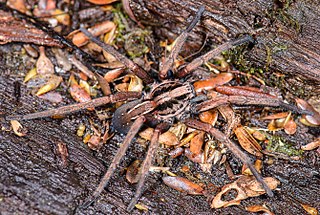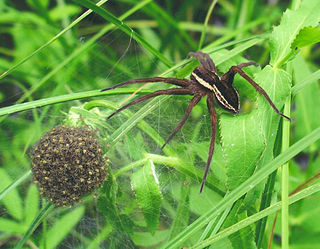
The family Dipluridae, known as curtain-web spiders are a group of spiders in the infraorder Mygalomorphae, that have two pairs of booklungs, and chelicerae (fangs) that move up and down in a stabbing motion. A number of genera, including that of the Sydney funnel-web spider (Atrax), used to be classified in this family but have now been moved to Hexathelidae.

Nursery web spiders (Pisauridae) is a family of araneomorph spiders first described by Eugène Simon in 1890. They resemble wolf spiders (Lycosidae) except for several key differences. Wolf spiders have two very prominent eyes in addition to the other six, while a nursery web spider's eyes are all about the same size. Additionally, female nursery web spiders carry their egg sacs with their jaws and pedipalps instead of attaching them to their spinnerets as wolf spiders do. When the eggs are about to hatch, a female spider builds a nursery "tent", places her egg sac inside, and stands guard outside, hence the family's common name. Like the wolf spiders, however, the nursery web spiders are roaming hunters that don't use webs for catching prey.

Miturgidae is a family of araneomorph spiders that includes nearly 170 species in 29 genera worldwide. First described by Eugène Simon in 1886, it has been substantially revised, and includes the previous family Zoridae as a synonym, and excludes the family Xenoctenidae. Several genera have also been removed, such as the large genus Cheiracanthium, which was transferred to the Cheiracanthiidae.

Corinnidae is a family of araneomorph spiders, sometimes called corinnid sac spiders. The family, like other "clubionoid" families, has a confusing taxonomic history. Once it was a part of the large catch-all taxon Clubionidae, now very much smaller. The original members of the family are apparently similar only in that they have eight eyes arranged in two rows, conical anterior spinnerets that touch and are generally wandering predators that build silken retreats, or sacs, usually on plant terminals, between leaves, under bark or under rocks.

Hexathelidae is a family of mygalomorph spiders. It is one of a number of families and genera of spiders known as funnel-web spiders. In 2018, the family was substantially reduced in size by genera being moved to three separate families: Atracidae, Macrothelidae and Porrhothelidae. Atracidae includes the most venomous species formerly placed in Hexathelidae.

Zoropsidae, also known as false wolf spiders for their physical similarity to wolf spiders, is a family of cribellate araneomorph spiders first described by Philipp Bertkau in 1882. They can be distinguished from wolf spiders by their two rows of eyes that are more equal in size than those of Lycosidae.

Dolomedes is a genus of large spiders of the family Pisauridae. They are also known as fishing spiders, raft spiders, dock spiders or wharf spiders. Almost all Dolomedes species are semiaquatic, with the exception of the tree-dwelling D. albineus of the southeastern United States. Many species have a striking pale stripe down each side of the body.

Idiopidae, also known as armored trapdoor spiders, is a family of mygalomorph spiders first described by Eugène Simon in 1889. They have a large body similar to tarantulas.

Barychelidae, also known as brushed trapdoor spiders, is a spider family with about 300 species in 42 genera.
Bymainiella is a genus of Australian funnel-web spiders that was first described by R. J. Raven in 1978. This genus is named in honour of the Australian arachnologist Barbara York Main.

Paraembolides is a genus of Australian funnel-web spiders that was first described by Robert John Raven in 1980.
Paraembolides boycei is a species of funnel-web spider in the Hexathelidae family. It is endemic to Australia. It was described in 1978 by Australian arachnologist Robert Raven.
Paraembolides cannoni is a species of funnel-web spider in the Hexathelidae family. It is endemic to Australia. It was described in 1978 by Australian arachnologist Robert Raven.
Paraembolides brindabella is a species of funnel-web spider in the Hexathelidae family. It is endemic to Australia. It was described in 1978 by Australian arachnologist Robert Raven.
Paraembolides grayi is a species of funnel-web spider in the Hexathelidae family. It is endemic to Australia. It was described in 1978 by Australian arachnologist Robert Raven.
Paraembolides montisbossi is a species of funnel-web spider in the Hexathelidae family. It is endemic to Australia. It was described in 1978 by Australian arachnologist Robert Raven.
Paraembolides tubrabucca is a species of funnel-web spider in the Hexathelidae family. It is endemic to Australia. It was described in 1978 by Australian arachnologist Robert Raven.

Paraembolides variabilis is a species of funnel-web spider in the Hexathelidae family. It is endemic to Australia. It was described in 1978 by Australian arachnologist Robert Raven.
Teranodes otwayensis is a species of funnel-web spider in the Hexathelidae family. It is endemic to Australia. It was described in 1978 by Australian arachnologist Robert Raven.










